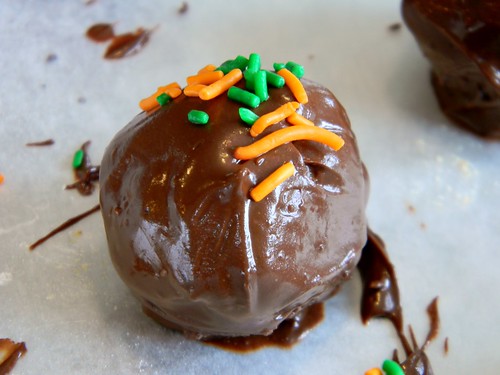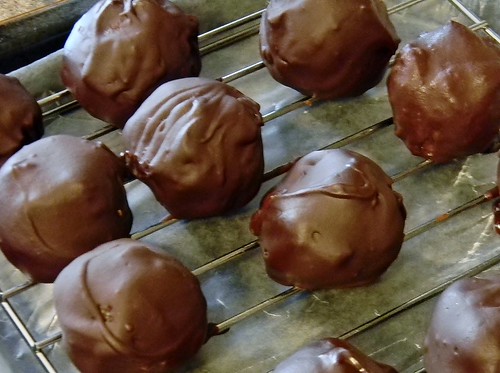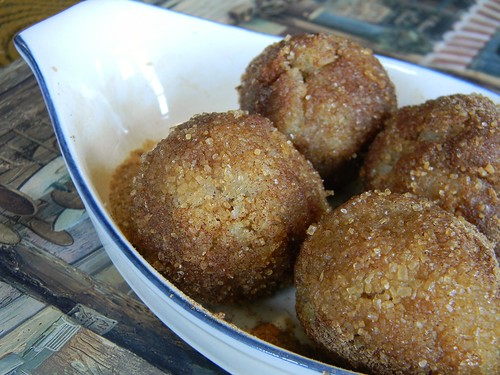Author: Dédé Wilson
Publisher: Harvard Common Press (2012)
Imagine – all the things you love about a piece of cake,
without the fuss and bother of storing a whole one in the fridge. Simple, I
know. Ever since I first saw these confections on Angie Dudley’s (AKA Bakerella’s)
blog, I’ve marvelled at how I didn’t think of the concept sooner! While a great
way to utilize stale, overbaked and even freshly baked cake leftovers, cake
balls provide a wonderfully blank canvas for experimentation. This creative potential
is made deliciously clear in the cookbook Cake Balls: More Than 60
Delectable and Whimsical Sweet Spheres of Goodness by Dédé Wilson,
contributor to Bon Appetit magazine.
 |
| Carrot Cake ‘n’ Cream Cheese Frosting Cake Balls (p. 63) |
Far from your standard “chocolate and vanilla” flavours, Cake
Balls offers 52 different twists – from a Toffee-Brown Butter Pecan (p. 132) to Creme Brulee (p. 82) and even Apple
Pie (p. 50). Wilson also includes recipes for the cakes, brownies and
frostings used in the balls, along with including a section called Cake Ball Creations (p. 140), which is
filled with fun and interesting ways to play with the basics (like making a Fairy Princess Ballerina (p.148)).
This book is great not only for the finished products’
combinations but also for the basic cakes and brownies that Wilson calls for in
the book themselves. The Banana Cake (p.
36) was moist and buttery, and was made even better the second time with an
extra banana and one less egg. My personal favourite, though, was the Fudgy Brownie (p. 37). I found it far
too sweet as written (especially since it’s intended to be mixed with frosting
and dipped in chocolate!), but the texture was definitely as Wilson described –
sticky and moist, perfect for shaping (she gives the caveat that these were not
meant to be served au naturale). If I was going to serve them as cut brownies,
I’d add three minutes to the bake time, cut the sugar to three-quarters of what
the recipe calls for and use partial brown sugar for added flavour and a more
familiar texture. It’s a simple formula that opens itself up to a world of
possibilities in both ball and bar form.
 |
| Banana-Caramel-Nut Cake Balls (p. 55) |
More problematic for me were the frostings and glaze I tried.
The Caramel Frosting (p. 44) was far
too greasy in texture, acting more like a hand cream than a “glue” when I tried
to use it in the Banana-Caramel-Nut Cake
Balls (p. 55). I loved the flavour of the filling for the Apple Pie Cake Balls (again, after
cutting the sugar in half), but it was again too greasy combined with the moist
cake. I’d use it for tarts and hand pies for sure, and when juxtaposed with a
savoury crust I’m sure it would really stand out. The Cream Cheese Frosting (p. 63), however, had no flaws on the palate
or with the consistency, being tangy enough to cut the sugar and sweet enough
to not simply taste like cheese. I will definitely go back to this recipe, and
in fact made several batches since I used it on a large slab cake. It also
fared well as a cake ball “glue” when I used it with scraps of trimmed carrot cake
for a partial batch of Carrot Cake ‘n’
Cream Cheese Frosting Cake Balls (p. 63). Not having white chocolate on
hand at the time, I used dark and upon serving it was told I should sell them
to Starbucks! Trying to make the Confectioners’
Sugar Glaze (p. 47), though, was more of a trial. Wilson indicates in the
recipe introduction that “[i]f you whisk the sugar and water together without
heating, the glaze will remain sticky” – a quality that isn’t overly desirable
in a portable snack. However, she never tells the reader how to heat the
mixture for a hard set, nor mentions it anywhere else in the book. Had I been
thinking, I would have gone back to Alton Brown’s Doughnut Glaze recipe which
has served me well.
The great thing about a treat such as Cake Balls
is that they are a product of versatility and even frugality. While Wilson’s
Bon Appetit history shows itself in her guides to tempering chocolate (p. 70), caramelizing sugar (in Creme Brulee Cake Balls (p.82)) and
working with “coating chocolate” (p.24),
she also includes incredibly useful “how-tos” for basic ball creation (p. 16) and basic ingredients and
techniques to be aware of (p. 20). Wilson
also realizes that time and/or cost is an issue for many home cooks, including “it’s
okay” notes about customizing the treats based on your personal preferences or
availabilities and using a box mix and canned frosting to whip up treats in a
pinch. Many readers will already be doing this to make their own “doughnut
holes” for bake sales, and while she doesn’t mention it using leftover, frosted
slices of cake (especially chocolate-on-chocolate types) can be easily broken
down to “ball paste”, rolled and dipped too.
 |
| Apple Pie Cake Balls (p. 50) |
The recipes in Cake Balls: More Than 60 Delectable and
Whimsical Sweet Spheres of Goodness are not perfect, but the idea of making
portable two-bite treats with the flavour of a full slice is a practical one
that will not be going away. The combinations of flavours and textures Dédé Wilson
shares in the book’s pages are great spins on plain concepts that can be made
with your favourite recipes without issue. This reason alone this book is worth
perusing, and if you forsee yourself contributing to bake sales, birthday
parties or sweet tables, you won’t be steered wrong.
Available on Amazon




